TL;DR Summary: Bold wall art serves as a powerful focal point that defines room character, creates emotional connections, and can increase property value. This comprehensive guide covers selection strategies, placement techniques, color coordination, and styling approaches backed by interior design experts and market research.
Introduction: Why Bold Wall Art Changes Everything
Bold wall art has become one of the most impactful design choices for homeowners looking to transform bland spaces into captivating environments. Walk into any home that feels truly finished, and you’ll likely notice striking artwork commanding attention from the walls. These aren’t just decorations—they’re conversation starters, mood setters, and the visual anchors that pull entire rooms together.
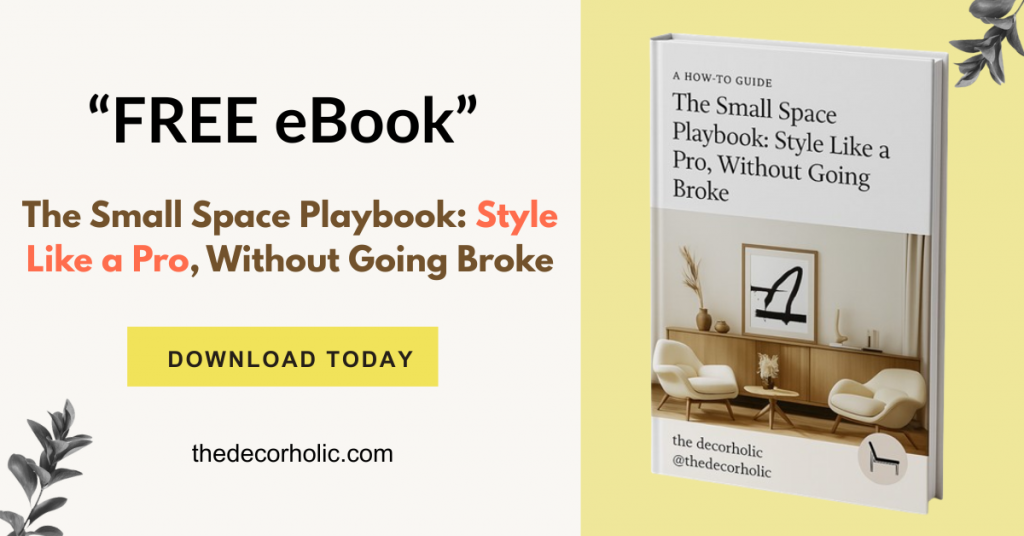
The wall art market tells a compelling story about our collective desire for meaningful spaces. Valued at over $63 billion globally in 2024, this industry continues expanding as more homeowners recognize that bare walls represent missed opportunities. Whether you’re decorating your first apartment or refreshing a longtime residence, understanding how to leverage bold wall art can elevate your space from ordinary to extraordinary.
This guide walks you through every aspect of selecting, placing, and styling bold wall art to create spaces that reflect your personality while maintaining design integrity.
I. What Makes Wall Art “Bold”?

Bold wall art commands attention through size, color, contrast, or subject matter, creating an immediate visual impact that defines a room’s character. These pieces don’t whisper from the sidelines—they make deliberate statements that anchor your design scheme and reflect your personal style.
Scale plays a primary role in boldness. Oversized pieces measuring 40 inches or larger naturally draw the eye and balance tall walls or high ceilings. A single large canvas above a sofa creates more impact than multiple smaller pieces scattered across the same wall.
Color intensity amplifies boldness significantly. Vibrant hues like deep emeralds, rich burgundies, or electric blues inject energy into neutral spaces. Even black-and-white pieces become bold through stark contrast and graphic composition.
Subject matter contributes to a piece’s boldness factor. Abstract expressionism, provocative photography, or unconventional themes challenge viewers and spark conversation. As renowned designer Kelly Wearstler notes in her design philosophy, dramatic elements in measured doses create the most compelling interiors.
Key characteristics of bold wall art:
- Substantial size – Minimum 30-40 inches in one dimension to create focal point impact
- Commanding colors – Saturated hues or striking contrasts that energize the space
- Strong composition – Clear visual hierarchy that guides the eye and creates movement
Pro Tip: Bold doesn’t always mean bright. A massive charcoal sketch or monochromatic photograph can be just as striking as a colorful abstract piece. Focus on visual weight rather than just color intensity.
You’ll Also Like: Calming Paint Colors: The Complete Guide to Creating Your Serene Home Sanctuary
II. Why Your Home Needs Bold Wall Art

Strategic wall art placement transforms empty walls into focal points, increases perceived property value, and creates emotional resonance with both residents and visitors. The investment in quality artwork pays dividends in both daily enjoyment and potential resale value.
Research from the National Association of Realtors reveals that proper home staging, which prominently features wall art, can increase property values between 1% and 10%. In their 2025 Profile of Home Staging, 83% of buyer’s agents confirmed that staged homes—with art as a key component—made it easier for buyers to envision properties as their future homes.
The psychological benefits extend beyond financial returns. Bold artwork sets the emotional tone of your space, influencing how you and your guests feel upon entering a room. Energizing abstracts invigorate home offices, while calming landscapes create sanctuary-like bedrooms.
Wall art also solves practical design challenges. Large empty walls can make rooms feel cold and unfinished, especially in modern homes with open floor plans and high ceilings. Strategic art placement creates visual balance and proper scale.
Bold wall art delivers multiple benefits:
- Defines room personality – Instantly communicates style and creates memorable first impressions
- Enhances property appeal – Staged homes with quality art sell 73% faster according to industry research
- Fills vertical space elegantly – Addresses tall walls and large expanses without clutter
Pro Tip: When selecting pieces for potential resale value, choose bold but broadly appealing subjects. Abstract art and landscape photography typically resonate across different taste preferences better than highly personalized or niche themes.
You’ll Also Like: Top 15 Property Staging Mistakes to Avoid
III. How to Choose the Right Bold Wall Art for Your Space

Start by assessing your room’s existing color palette, architectural features, and functional purpose, then select artwork that complements these elements while adding the desired emotional impact. This methodical approach ensures your bold choices enhance rather than clash with your overall design.
Room function influences appropriate art choices. Living rooms benefit from conversation-starting pieces that reflect your personality, while bedrooms call for calmer subjects that promote relaxation. Home offices thrive with motivational or thought-provoking artwork that inspires productivity.
Your existing color scheme provides the foundation for smart selections. Pull accent colors from your artwork to coordinate with throw pillows, rugs, or decorative objects, creating a cohesive look. Alternatively, choose pieces that introduce completely new colors to add unexpected visual interest.
Scale matters enormously in achieving proper balance. For spaces above furniture, artwork should span roughly two-thirds to three-quarters the furniture width. A 90-inch sofa pairs beautifully with a 60-72 inch piece or gallery arrangement.
Selection criteria for maximum impact:
- Color coordination – Either complement existing hues or introduce intentional contrasts that energize
- Appropriate scale – Match artwork dimensions to wall size and adjacent furniture proportions
- Personal connection – Choose pieces that resonate emotionally rather than following trends alone
Pro Tip: Take photos of your space from multiple angles, then digitally overlay potential artwork images to visualize how pieces will look. Many retailers now offer AR apps that virtually place art on your actual walls through your smartphone camera.
You’ll Like This Popular Post: How To Create An Art Gallery Wall
IV. Understanding Bold Wall Art Styles

Contemporary bold wall art encompasses multiple aesthetic approaches, from abstract expressionism and modern photography to mixed media and digital art, each creating distinct visual impacts and emotional responses. Understanding these categories helps you identify what resonates with your taste while fitting your design vision.
Abstract Art
Available on Wayfair
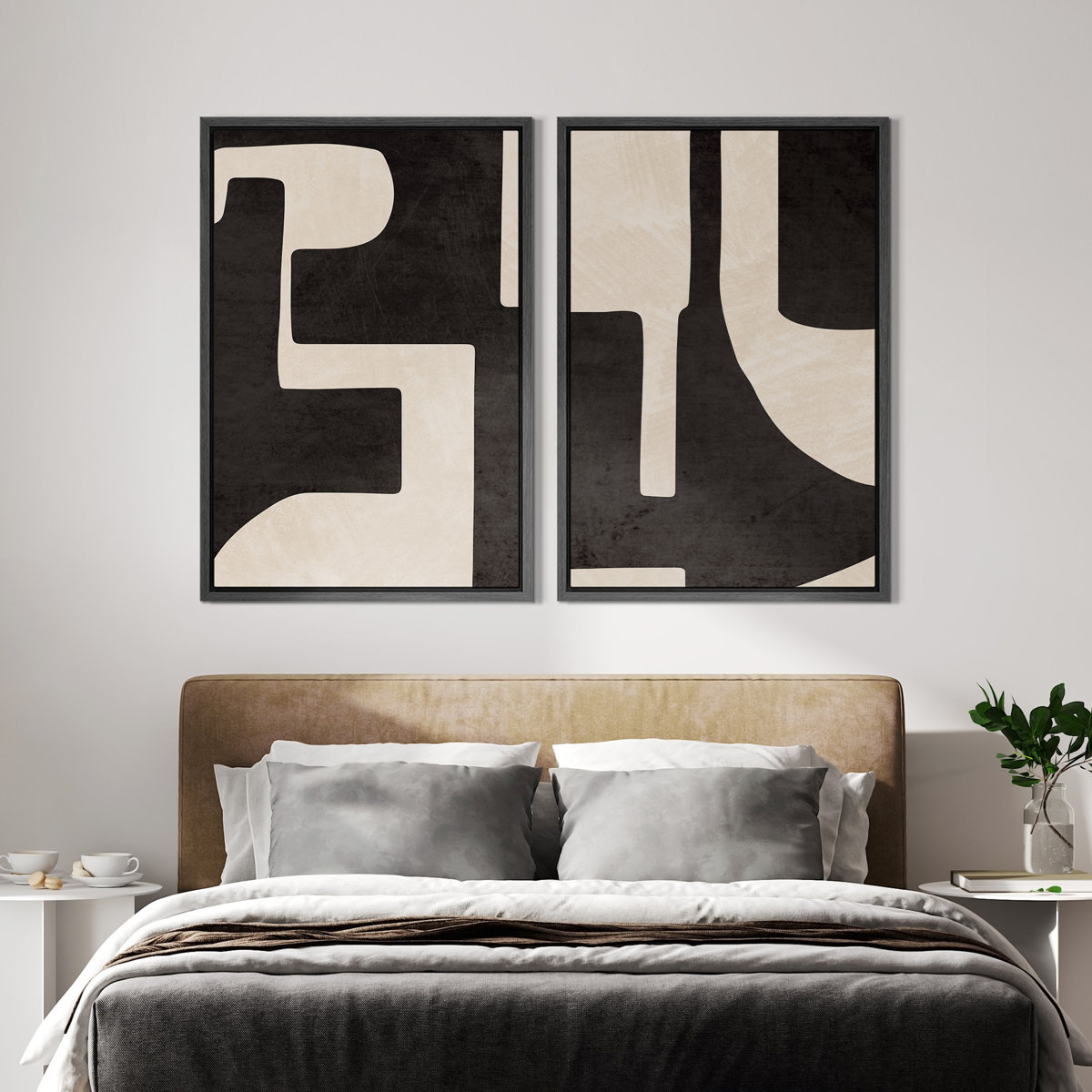
Mid-Century Geometric Canvas Wall Art (Set of 2)
This set of two framed canvas prints features bold black and cream geometric shapes with abstract paint strokes. A perfect neutral accent for modern interiors, it adds depth and sophistication to any space.
Check Price on WayfairRemains the most popular bold choice for modern interiors. Its non-representational forms allow personal interpretation while introducing dynamic colors and shapes. Large-scale abstracts work exceptionally well in minimalist spaces where they provide necessary visual complexity.
Photography Art
Available On Wayfair
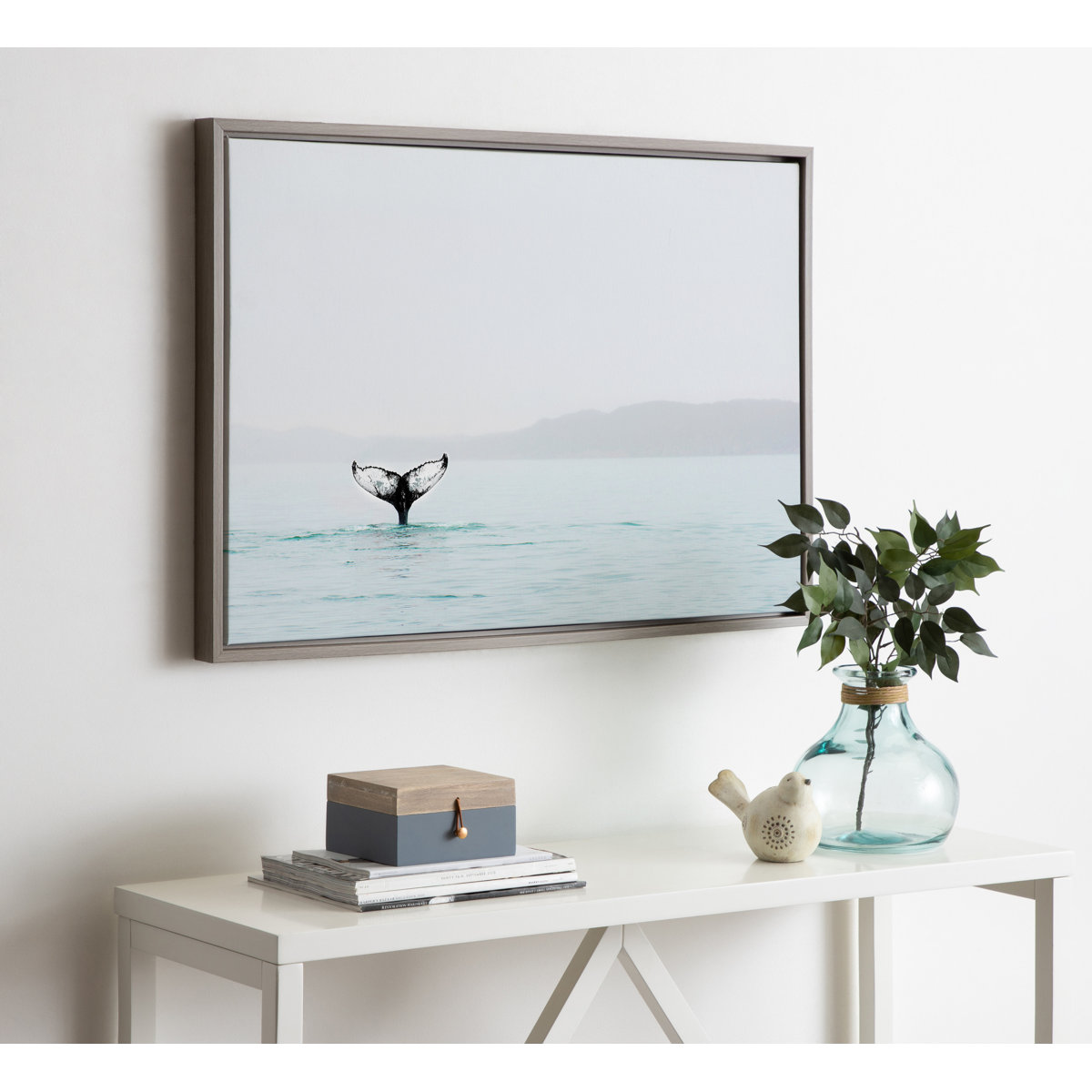
Whale Tail in the Mist by Amy Peterson
Embrace the mystery of the sea with this ethereal canvas print featuring a whale tail emerging from the mist. Framed in a sleek floater style, it brings coastal serenity and artistic elegance to any space.
Check Price on WayfairHas evolved into serious artistic medium for bold statements. Oversized black-and-white portraits, dramatic landscape panoramas, or architectural studies bring sophistication and cultural relevance to contemporary homes. The medium’s realistic nature makes it accessible while still providing strong visual impact.
Textural Art Pieces
Available on Wayfair
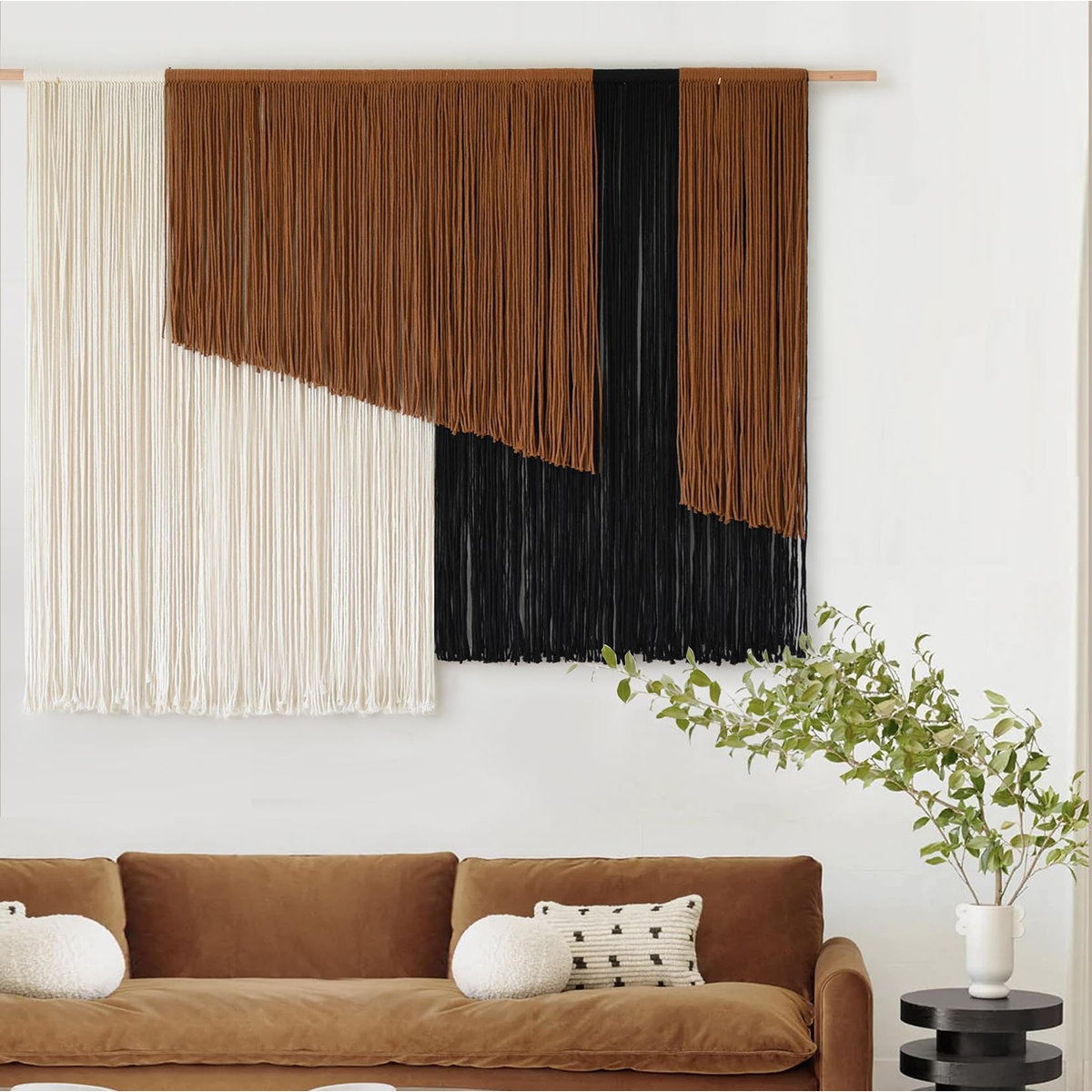
Large Dip-Dyed Macrame Wall Hanging
Add boho charm to your space with this oversized macramé wall hanging. Featuring hand-knotted cotton cords and a soft dip-dyed gradient, it’s perfect for creating a cozy, artistic focal point in your living room or bedroom.
Check Price on WayfairIncorporate dimensional elements that create depth beyond flat surfaces. Macramé wall hangings, fiber art panels, or mixed-media works with raised elements add tactile interest that particularly suits bohemian and eclectic interiors.
Typography-Based Art
Available On Wayfair
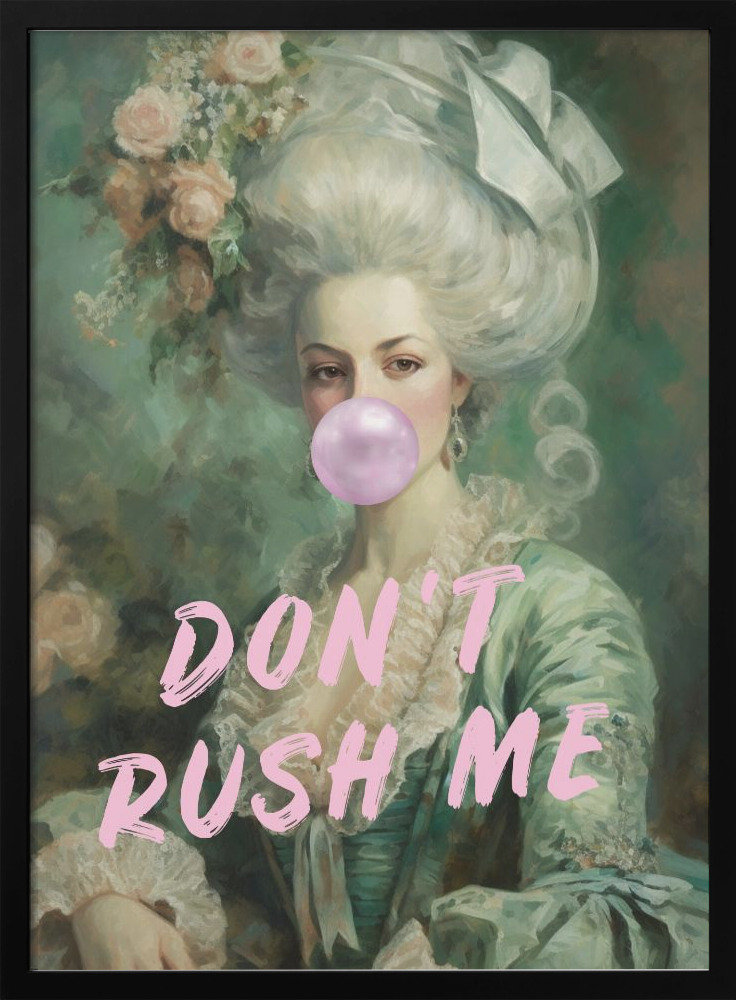
“Don’t Rush Me” Retro Pop Art Print
Add a bold statement to your walls with this framed pop art print featuring a vintage comic-style character and cheeky quote. Perfect for modern, eclectic, or retro-inspired spaces that need a splash of personality.
Check Price on WayfairUses powerful words, quotes, or letters as focal points. These pieces work brilliantly in offices, entryways, or any space where you want to communicate specific messages or values.
Popular bold art styles and their ideal settings:
- Abstract expressionism – Best for modern living rooms and open-concept spaces requiring strong focal points
- Large-scale photography – Perfect for sophisticated dining rooms and primary bedrooms seeking refined elegance
- Mixed media and textural works – Ideal for eclectic spaces, creative studios, or rooms with predominantly smooth surfaces
Pro Tip: Don’t limit yourself to traditional framed canvases. Sculptural wall art, vintage architectural salvage, or even suspended textile installations can serve as bold statements that express your unique style more authentically than conventional pieces.
Disclaimer: This post may contain affiliate links. I earn a commission on qualifying purchases at no additional cost to you.
You’ll Also Like: Moody Living Room: The Complete Design Guide for Renters Creating Drama with Dark, Sophisticated Style
V. Perfect Placement: Where to Hang Bold Wall Art
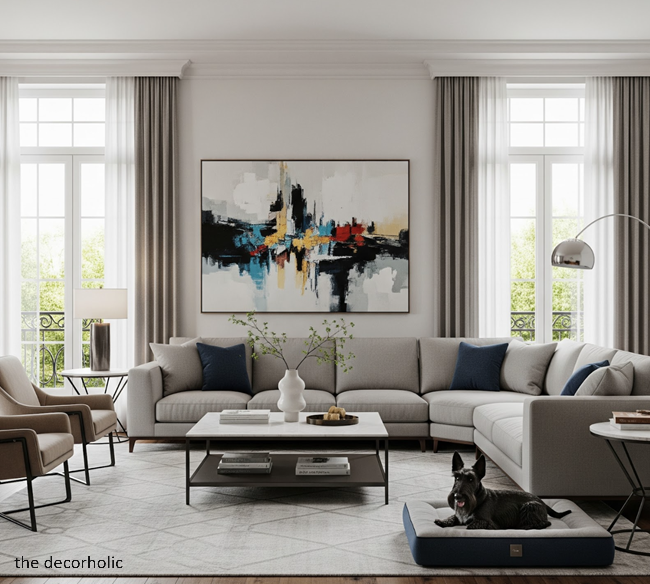
Position bold artwork at eye level (57-60 inches from floor to center), ensuring proper relationship with furniture while maintaining adequate breathing room around the piece. Professional placement creates visual harmony and maximizes the artwork’s impact throughout your space.
The standard eye-level guideline works well for most situations, but adjust based on room function. In dining rooms where people sit, lower artwork slightly to maintain connection when seated. Gallery walls can start at 57 inches for the central piece, with surrounding works arranged around this anchor.
Furniture relationships matter significantly. Leave 6-10 inches between your sofa top and artwork bottom to create connection without crowding. For beds, maintain 8-12 inches of space to achieve similar balance while ensuring the piece doesn’t feel like it’s falling on sleepers.
Lighting transforms good placement into great presentation. Natural light showcases artwork beautifully during daytime hours, but avoid direct sunlight that causes fading. Picture lights or track lighting provides focused illumination that makes pieces pop during evening hours.
Placement guidelines for professional results:
- Standard height formula – Center artwork at 57-60 inches from floor for optimal viewing comfort
- Furniture spacing – Maintain 6-12 inches between furniture tops and artwork bottoms for visual balance
- Wall coverage calculation – Bold pieces should occupy 60-75% of available wall width for proper proportion
Pro Tip: Use painter’s tape to outline your artwork’s dimensions on the wall before hanging. Live with this template for a few days, observing how it looks from different angles and times of day. This preview prevents costly placement mistakes with heavy or expensive pieces.
Don’t Miss This Blog Post: No-Fail Formula to Create a Gallery Wall
VI. Color Coordination Strategies for Bold Art

Select artwork that either harmonizes with your existing palette through analogous colors or creates intentional contrast through complementary hues, ensuring the piece integrates cohesively while achieving desired visual impact. Masterful color coordination makes the difference between artwork that enhances your space and pieces that feel disconnected.
The color wheel provides your roadmap for successful combinations. Analogous schemes use adjacent colors—like blues, greens, and teals—creating harmonious, calming environments. Complementary pairings—such as blue and orange or purple and yellow—generate energetic tension that commands attention.
Neutral rooms offer the most flexibility for bold color introductions. If your walls, floors, and major furniture pieces stay neutral, vibrant artwork can introduce any color family without clashing. This approach allows seasonal accessory changes while maintaining your art investment.
Pulling accent colors from your artwork throughout the room creates professional cohesion. If your bold piece features touches of coral, echo that hue in throw pillows, vases, or decorative objects. This technique ties everything together while letting the artwork remain the hero.
Color coordination approaches:
- Monochromatic harmony – Choose artwork featuring varied tones of your dominant room color for sophisticated unity
- Accent extraction – Select 2-3 colors from your bold piece and repeat them in smaller accessories
- Neutral anchoring – Let vibrant artwork provide all color interest in predominantly neutral spaces
Pro Tip: When working with bold multicolored artwork, follow the 60-30-10 rule. Use your room’s dominant color for 60% of surfaces, secondary color for 30% of furnishings, and the bold artwork’s most vibrant accent for just 10% of accessories. This creates visual interest without overwhelming the senses.
Don’t Miss This Post: 30 Interior Decorating Rules You Can (and Should!) Break
VII. Creating Gallery Walls with Bold Pieces
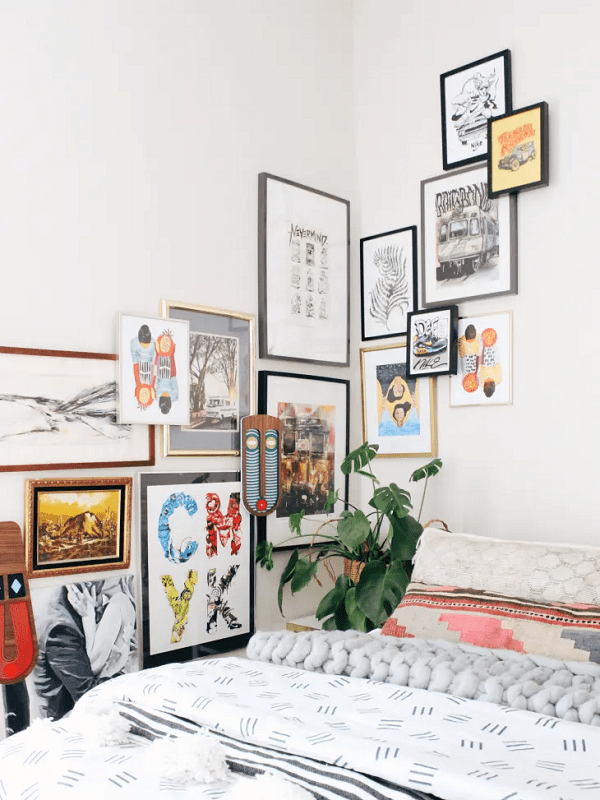
Build gallery walls around one dominant bold piece, surrounding it with complementary smaller works that support rather than compete, maintaining consistent spacing of 2-3 inches between frames. This curated approach delivers the visual interest of multiple pieces while preserving focal point clarity.
Start with your largest, most striking piece as the anchor. Position this at the center or slightly offset, then arrange smaller supporting pieces around it. This hierarchy prevents the scattered look that undermines many gallery wall attempts.
Frame consistency brings cohesion to eclectic collections. While artwork styles can vary dramatically, maintaining uniform frame materials, colors, or widths creates visual unity. All black frames, all natural wood, or all white mats provide the structure that allows diverse art to coexist harmoniously.
Grid layouts offer an alternative to organic arrangements for those who prefer structure. Install same-sized pieces in perfect rows with uniform spacing, creating a modern, intentional look. This approach works particularly well with photography series or thematic collections.
Gallery wall construction guidelines:
- Central anchor principle – Position your boldest, largest piece first, then build around it systematically
- Consistent spacing – Maintain 2-3 inches between all frames for professional, curated appearance
- Frame coordination – Match frame styles, colors, or materials even when artwork varies significantly
Pro Tip: Create your gallery wall layout on the floor first, arranging and rearranging until you find the perfect composition. Take a photo from above to reference when hanging, or trace each frame on kraft paper, tape the papers to your wall, and use them as templates for precise nail placement.
Another Post You’ll Like: 9 Small Powder Room Genius Hacks
VIII. Bold Art in Different Room Types
Tailor artwork selection to room function: energizing pieces for active spaces like kitchens and home offices, calming subjects for bedrooms and bathrooms, with living and dining rooms offering maximum flexibility for personal expression. Each space in your home serves distinct purposes that artwork can enhance or undermine.
Living Rooms

Function as entertainment and relaxation zones where bold art makes the strongest statement. This prime real estate deserves your most impressive pieces—large abstracts, striking photography, or meaningful collections that spark conversation. Position artwork above the sofa or on the wall opposite your main seating to ensure visibility.
Bedrooms
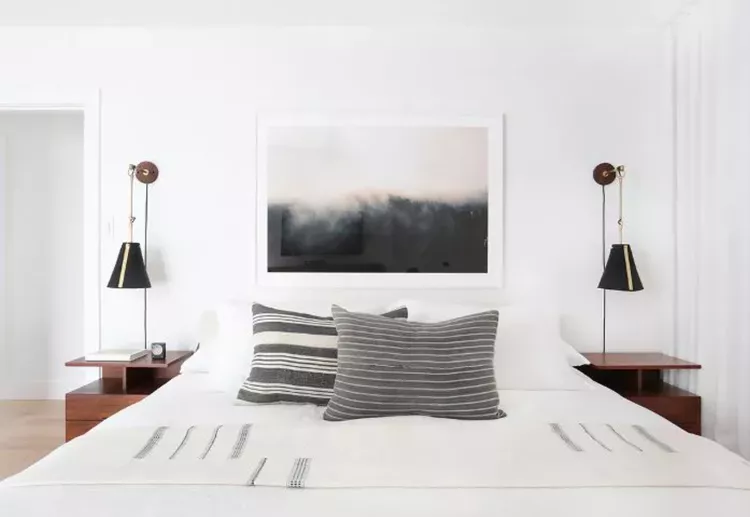
Require careful consideration since artwork influences sleep quality and morning moods. Opt for bold colors in calming hues like deep blues, soft greens, or warm earth tones. Nature scenes, abstract pieces with flowing lines, or serene photography creates sanctuary-like atmospheres while maintaining visual interest.
Home Offices

Benefit from motivational and thought-provoking artwork that inspires productivity without causing distraction. Bold typography, architectural photography, or abstract pieces in energizing colors keep creative energy flowing. Avoid overly complex or chaotic compositions that fragment focus.
Kitchens and Dining Rooms


Offer opportunities for playful boldness. Food-related photography, vibrant abstracts, or colorful vintage posters inject personality into these gathering spaces. Since these rooms typically feature busy visual elements from cabinetry and appliances, keep artwork selections focused rather than cluttered.
Room-specific art selection:
- Living rooms – Maximum flexibility for personal style expression and conversation-starting pieces
- Bedrooms – Bold colors in calming palettes that promote relaxation while adding visual interest
- Home offices – Motivational pieces that inspire productivity without creating visual chaos
Pro Tip: Consider the room’s existing visual complexity when selecting bold art. Minimalist spaces with clean lines can handle maximalist, busy artwork, while rooms with patterned textiles and architectural details benefit from simpler, more focused pieces that don’t compete for attention.
Trending Post You’ll Like: Best Stud Finder: Your Essential Tool for Home Decor
IX. Sizing Guide: How Big Should Your Bold Art Be?

Match artwork dimensions to wall space and adjacent furniture: solo pieces should cover 60-75% of available wall width, while the bottom of artwork should sit 6-12 inches above furniture tops for proper visual connection. Proper sizing creates professional-looking proportion that maximizes impact.
For walls above furniture like sofas or beds, calculate two-thirds to three-quarters of the furniture width as your target artwork span. A 90-inch sofa works beautifully with a 60-72 inch piece or gallery arrangement. This formula ensures the artwork feels purposefully related to the furniture without overwhelming or underwhelming the composition.
Standalone walls without furniture offer more flexibility but require careful consideration to avoid pieces floating in space. Artwork on these walls should occupy approximately 60% of the wall width while remaining balanced with the room’s other visual elements.
Ceiling height influences appropriate artwork dimensions. Standard 8-foot ceilings accommodate pieces up to 40 inches tall comfortably, while 10-foot ceilings call for 50-60 inch heights to maintain proportion. Larger pieces feel lost on short walls but perfect for grand spaces with architectural volume.
Professional sizing formulas:
- Above furniture rule – Artwork should span 60-75% of furniture width for optimal visual balance
- Standalone wall calculation – Pieces should occupy roughly 60% of total wall width
- Height considerations – Allow artwork to use 2/3 to 3/4 of available vertical space between furniture and ceiling
Pro Tip: When hanging multiple pieces as a grouping, calculate the total combined dimensions as your artwork size. A collection of four 20×20 inch pieces arranged in a square creates a 40×40 inch visual unit that should follow the same sizing guidelines as a single large canvas.
You’ll Also Like This Post: Best Sofa for Small Spaces: Transform Tiny Rooms Into Stylish Sanctuaries
X. Budget-Friendly Bold Art Solutions

Create high-impact wall art affordably through large-scale DIY canvas projects, framed textile pieces, or curated vintage finds, achieving bold statements without luxury price tags. Strategic creativity often produces more personalized results than expensive purchases.
DIY Abstract Canvases
Offer the most accessible entry into bold art. Purchase large pre-stretched canvases from art supply stores, select a few complementary paint colors, and experiment with pouring, dripping, or broad stroke techniques. Even amateur efforts create striking abstract pieces indistinguishable from gallery offerings when executed with confidence.
Textile Art
Provides another budget-conscious bold option. Frame vintage scarves, colorful fabric yardage, or even wallpaper samples in oversized frames for instant impact. This approach works particularly well for bohemian, eclectic, or global-inspired interiors where texture matters as much as imagery.
Print-on-Demand
Services have democratized access to museum-quality reproductions and contemporary designs. These services offer thousands of artists’ works printed on canvas, with sizes up to 60+ inches available at fraction of original art costs.
Skip the endless search for safe art and apply your new knowledge by exploring my curated selection of downloadable prints, guaranteed to deliver the bold, confident look your space deserves.
Vintage markets, thrift stores, and estate sales yield unexpected treasures. Oversized vintage maps, architectural drawings, or retro advertising posters bring character and authenticity to spaces while costing substantially less than contemporary pieces.
Affordable bold art strategies:
- DIY abstract techniques – Create custom pieces using large canvases and acrylic paints for under $100
- Frame-worthy textiles – Transform vintage scarves, fabric, or wallpaper samples into bold statement pieces
- Print-on-demand art – Access thousands of designs printed at large scale for $100-300
Pro Tip: Mix affordable DIY or printed pieces with one or two investment-quality originals to create galleries that look entirely high-end. The combination prevents your space from feeling too generic while keeping overall costs manageable.
You’ll Also Like:10 Best Modular Sectional Sofas on Amazon
XI. Framing and Presentation Options

Choose framing that enhances artwork without overpowering it: simple frames for busy compositions, ornate frames for minimal subjects, with float mounting and frameless options offering contemporary alternatives. Presentation quality dramatically affects perceived artwork value and overall visual impact.
Frame selection requires balancing artwork style with room aesthetics. Traditional or representational pieces often benefit from classic wood frames with subtle detailing, while contemporary abstracts frequently look best in simple metal or black wood frames that don’t compete for attention.
Float mounting creates sophisticated presentation for canvas work. The piece sits slightly forward from the frame backing, creating dimensional shadow that adds visual interest. This technique works especially well for modern and contemporary artwork displayed in transitional or contemporary interiors.
Frameless edge-mounted plexiglass offers ultra-modern presentation for photography and digital art. The print mounts directly to clear acrylic sheets that stand off from the wall, creating floating appearance. This museum-quality approach suits minimalist and contemporary spaces beautifully.
Mat selection influences perceived artwork value significantly. Wider mats—3 to 4 inches—create gallery-level presentation that makes even modest pieces feel important. Choose mat colors that appear within the artwork to create visual connection between piece and frame.
Framing approaches by style:
- Traditional portraits and landscapes – Classic wood frames with depth and subtle detailing
- Contemporary abstracts and modern photography – Simple black, white, or metallic frames with clean lines
- Canvas artwork – Float mounting or frameless presentation for dimensional appeal
Pro Tip: When framing multiple pieces for a gallery wall, vary the mat widths while keeping frames consistent. This technique adds visual interest while maintaining cohesive look. Larger mats around smaller pieces create similar visual weight to bigger works with narrower mats.
You’ll Also Like: Best Home Tool Kits: Stop Wasting Money on Emergency Handyman Calls
XII. Lighting Your Bold Wall Art

Illuminate artwork with dedicated picture lights or adjustable track lighting positioned at 30-degree angles, providing 3 times the ambient room illumination for proper visibility without glare. Professional lighting transforms good artwork into stunning focal points while protecting pieces from damage.
Picture lights mount directly above or below artwork, casting even illumination across the surface. Modern LED options eliminate heat concerns while providing adjustable color temperature. Choose warm white (2700-3000K) for traditional art and neutral white (3500-4000K) for contemporary pieces.
Track lighting offers flexibility for rooms with multiple artworks or changing displays. Install tracks with adjustable heads that can redirect as your collection evolves. Position lights to shine at 30-degree angles to minimize glare and showcase texture effectively.
Natural light displays artwork beautifully but requires protection from direct sun exposure. UV-filtering glass or acrylic prevents fading while allowing you to enjoy daylight presentation. Position valuable pieces on walls perpendicular to windows rather than directly across from them.
Lighting strategies for maximum impact:
- Dedicated picture lights – Mount LED fixtures directly above artwork for focused, museum-quality illumination
- Adjustable track systems – Install flexible rails that accommodate multiple pieces and future changes
- UV protection measures – Use filtering glazing on valuable pieces exposed to natural light
Pro Tip: Layer your artwork lighting with room ambience for dimensional effect. When your picture lights shine at full brightness while room lights dim, artwork pops dramatically. Install all lighting on dimmer switches to control intensity based on time of day and desired mood.
You’ll Also Like: 25 Easy Renter Friendly Hacks On The Budget
XIII. Styling Around Your Bold Art
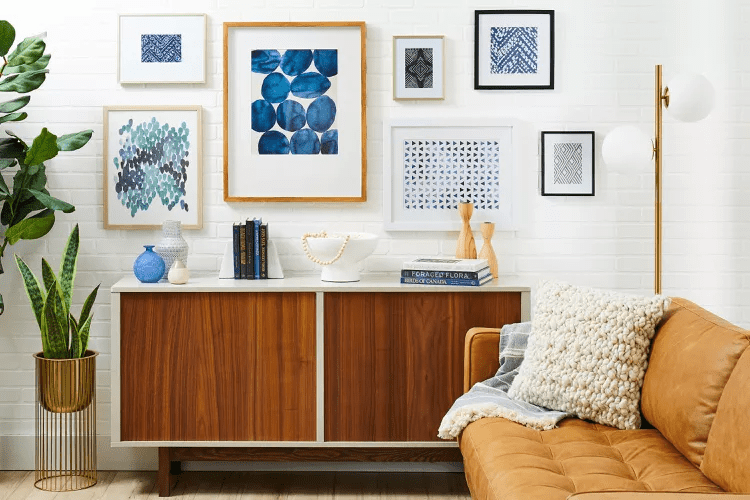
Build room design by pulling colors from artwork into accessories, coordinating furniture styles with the piece’s aesthetic, and balancing bold statements with simpler surrounding elements. Strategic styling creates cohesive interiors where artwork feels intentionally integrated rather than randomly placed.
Color Extraction
Remains the most reliable styling technique. Identify the three or four most prominent colors in your bold piece, then repeat them throughout the space in varying proportions. The artwork’s dominant hue might appear in curtains, secondary colors in throw pillows, and accent colors in decorative objects.
Furniture Style
Should harmonize with artwork aesthetic. Mid-century modern furniture complements bold abstracts beautifully, while traditional pieces pair well with classic landscapes or portraiture. Mixed styles work when unified through color or material connections.
Balance
Prevents visual overwhelm in rooms featuring bold art. If your artwork explodes with color and pattern, surrounding furnishings should offer visual rest through solid fabrics and simple silhouettes. Conversely, maximalist furnishings benefit from more subdued artwork that provides focal points without adding chaos.
Negative Space
Around artwork allows pieces to breathe. Avoid cramming walls with multiple competing elements. If you’ve invested in bold statement art, give it prominence by keeping adjacent walls relatively clear or decorated with subtle, supporting elements.
Styling coordination techniques:
- Color echo method – Repeat artwork colors in 3-5 accessories distributed throughout the room
- Style harmony principle – Match furniture periods and aesthetics to artwork’s general vibe
- Visual balance strategy – Pair maximalist art with minimalist surroundings and vice versa
Pro Tip: Create a small styling board before purchasing accessories. Photograph your artwork, print or screenshot your major furniture pieces, and digitally arrange them with potential accessory additions. This preview prevents costly mistakes and helps you shop with clear vision.
Don’t Miss This Post: Secrets to Mixing Textures at Home Like an Interior Designer
IVX. Common Bold Wall Art Mistakes to Avoid
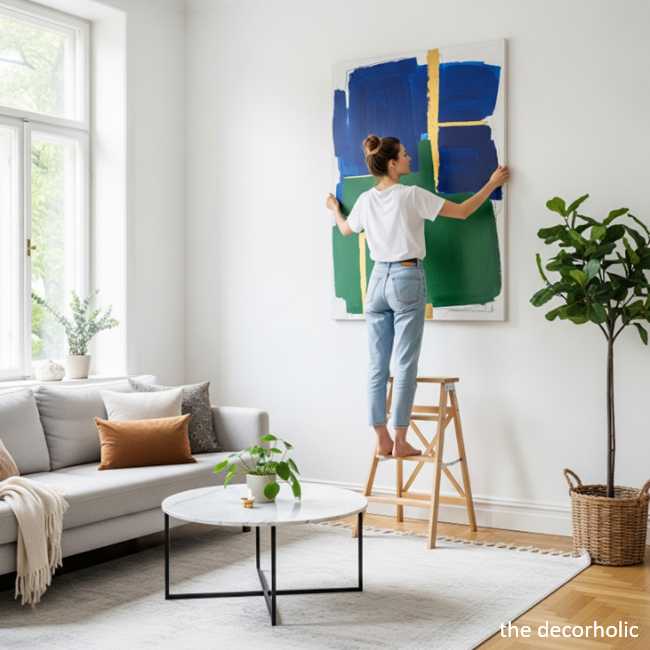
Prevent design failures by properly sizing pieces to space, hanging at correct heights, and ensuring artwork complements rather than clashes with existing room elements. Understanding common pitfalls helps you make confident choices that enhance rather than detract from your space.
Undersizing ranks as the most frequent error. Tiny artwork on expansive walls feels lost and unintentional, failing to create the impact you desire. When in doubt, size up. Oversized pieces might initially seem dramatic, but they quickly feel right as you adjust to their presence.
Incorrect hanging height undermines even perfect artwork selections. Too high and pieces disconnect from the space, floating awkwardly near the ceiling. Too low and they crowd furniture or force uncomfortable viewing angles. The 57-60 inch center point guideline works for vast majority of situations.
Clashing styles create visual confusion that prevents rooms from feeling cohesive. Ultra-modern abstract art rarely succeeds in traditional Victorian interiors, just as pastoral landscapes feel odd in industrial lofts. While eclectic mixing can work beautifully, it requires careful curation rather than random combination.
Ignoring lighting leaves artwork in shadows where its impact vanishes. Natural light alone rarely provides adequate illumination, especially for evening viewing. Budget for proper artwork lighting when planning your purchase to ensure you’ll enjoy pieces fully.
Errors that undermine bold art impact:
- Severe undersizing – Selecting pieces too small for wall space, creating disconnected, unfinished appearance
- Height miscalculation – Hanging too high or low, disrupting visual flow and viewing comfort
- Style mismatching – Forcing artwork into spaces where aesthetic conflicts create visual discord
Pro Tip: Before committing to controversial or extremely bold choices, use temporary solutions to test your reactions. Hang a large poster or fabric mock-up in place for several weeks. If you still love the bold direction after living with the preview, proceed with confidence knowing the permanent investment will satisfy long-term.
Don’t Miss This Post: How to Style a Sideboard: Room-by-Room Decorating Guide

XV. Maintaining and Caring for Your Wall Art

Preserve artwork value through gentle dusting, climate control, and protective framing while avoiding direct sunlight, excessive humidity, and harsh cleaning products. Proper care ensures your bold pieces remain vibrant focal points for decades rather than deteriorating prematurely.
Regular dusting prevents buildup that dulls colors and damages surfaces over time. Use soft, lint-free microfiber cloths or special art-cleaning brushes with natural bristles. Work gently with light pressure, moving in single direction rather than circular scrubbing that can scratch delicate surfaces.
Climate stability matters more than specific temperature or humidity levels. Dramatic fluctuations cause materials to expand and contract, leading to warping, cracking, or separation. Maintain consistent conditions between 65-75°F with 40-50% relative humidity for optimal preservation.
UV protection prevents fading that robs artwork of vibrancy. Museum-quality UV-filtering glass or acrylic blocks harmful rays while allowing visible light through. This investment proves particularly crucial for pieces displayed near windows or under bright artificial lighting.
Professional cleaning addresses issues beyond routine maintenance capabilities. Canvas restoration specialists can repair tears, remove stains, or revitalize varnish on valuable pieces. Schedule professional assessment every 5-10 years for investment-quality artwork to address developing problems before they become irreversible.
Essential care practices:
- Gentle cleaning routine – Dust monthly with soft cloths, avoiding harsh chemicals or excessive pressure
- Environmental stability – Maintain consistent temperature and humidity to prevent material degradation
- UV ray protection – Install filtering glazing on valuable pieces exposed to natural or bright artificial light
Pro Tip: Document your artwork collection with photographs, purchase receipts, and certificates of authenticity. Store these records separately from the pieces themselves for insurance purposes. This documentation proves invaluable if you need to file claims or sell pieces in the future.
You’ll Also Like: How to Style a Sideboard: Room-by-Room Decorating Guide
XVI. Working with Interior Designers on Art Selection

Leverage design professionals’ expertise in spatial planning, color theory, and art sourcing while maintaining final decision authority over pieces that will reflect your personal taste and style. Designers facilitate the process without removing your creative control.
Interior designers offer objective perspective on proportion and scale that’s difficult to judge independently. They’ve seen countless installations and can predict how specific pieces will function in your unique space. This experience prevents costly sizing or style mistakes that undermine your vision.
Access to trade resources expands your options significantly. Designers maintain relationships with art galleries, custom framers, and specialized vendors unavailable to general public. They can source exclusive pieces, negotiate favorable pricing, or commission custom work tailored precisely to your specifications.
Color and style expertise ensures cohesive results. Designers understand how to balance bold statements with surrounding elements, preventing spaces from feeling either bland or chaotic. They can identify exactly which accent colors to pull from artwork and where to incorporate them for maximum impact.
Budget management becomes more strategic with professional guidance. Rather than spending impulsively on pieces that later feel wrong, designers help allocate funds effectively across multiple rooms or stages. They know which items warrant investment and where affordable alternatives suffice.
Designer collaboration benefits:
- Objective spatial assessment – Professional evaluation of scale, placement, and proportion requirements
- Trade access advantages – Connections to exclusive galleries, artists, and resources beyond public availability
- Cohesive vision development – Expert coordination of artwork with overall design scheme for unified results
Pro Tip: When working with designers, clearly communicate your artwork budget upfront and specify whether you’re open to custom commissions or prefer ready-made pieces. This transparency helps designers source appropriate options without wasting time on solutions beyond your means or interest.
Most Popular Post:
Interior Design Style Quiz
Timeless Paint Colors That Never Go Out of Style
Create Your Perfect Ergonomic Home Office: A Complete Guide
Must-Have Accessories for Guys: The Secret to a Stylish Space
Modular Sofas for Small Spaces: Brilliant Solutions for Compact Living
Conclusion: Making Bold Moves with Confidence
Bold wall art transforms houses into homes that authentically express who you are while creating environments that inspire and energize daily life. The pieces you choose become more than decoration—they’re investments in your psychological wellbeing, property value, and personal satisfaction with your space.
Start with rooms where you spend the most time, selecting artwork that resonates emotionally while complementing your existing design elements. Apply the sizing, placement, and coordination principles covered throughout this guide to ensure your bold choices enhance rather than overwhelm your spaces.
Remember that perfect selections rarely happen instantly. Visit galleries, browse online collections, and live with mock-ups before committing to major pieces. The best artwork strikes that perfect balance between immediate attraction and lasting satisfaction that deepens over time.
Your walls offer blank canvases waiting for your creative direction. Whether you invest in single statement piece or build curated galleries spanning multiple walls, bold artwork gives your home the personality and visual interest that makes it distinctly yours.
Ready to transform your space? Start by identifying one wall in your home that feels incomplete or uninspiring. Use the strategies in this guide to select and properly install bold artwork that turns that forgotten wall into your favorite focal point.
Bold Wall Art-Frequently Asked Questions
Q: How much should I spend on bold wall art?
A: Budget 5-15% of your room’s total furnishing costs for artwork. A well-appointed $10,000 living room design should include $500-1,500 for quality wall art. Prioritize rooms where you spend the most time and guests visit frequently—living rooms, dining rooms, and primary bedrooms. Mix investment pieces with affordable options to maximize impact across your budget.
Q: Can I mix different bold art styles in the same room?
A: Yes, but maintain unifying elements like frame consistency, color harmony, or compositional similarity. Successfully eclectic galleries often share either frame style, dominant color palette, or subject matter theme while varying in artistic approach. Limit yourself to 2-3 distinct styles per room to prevent visual chaos that undermines each piece’s impact.
Q: What if I get tired of bold artwork after a few years?
A: Bold pieces have remarkable staying power when properly selected. Choose artwork you connect with emotionally rather than trendy subjects that feel dated quickly. Abstract art and photography age better than literal representations tied to specific periods. If tastes evolve, simply move pieces to different rooms where fresh context revitalizes your appreciation.
Q: How do I hang extremely heavy artwork safely?
A: Use heavy-duty picture hangers rated for twice your artwork’s weight. For pieces over 50 pounds, install into wall studs using wood screws rather than relying on drywall anchors. Professional installation costs $100-200 but provides peace of mind and proper secure mounting that prevents expensive damage from falls.
Q: Should bold wall art match my furniture exactly?
A: No—perfect matching creates flat, uninspired spaces. Instead, coordinate through accent colors or complementary hues that tie elements together without identical duplication. Your artwork should introduce visual interest that furniture alone cannot provide while maintaining harmonious relationship through strategic color connections.
Q: Is it okay to use multiple colors from my bold art throughout the room?
A: Absolutely—this technique creates professional cohesion. Select 3-5 colors from your artwork and repeat them in varying proportions across textiles, accessories, and smaller furnishings. The most prominent artwork color might appear in curtains, secondary hues in pillows, and accent colors in decorative objects, creating intentional visual flow.
Q: How often should I change my bold wall art?
A: Quality bold pieces should satisfy for 5-10 years or longer. Rather than frequent replacement, rotate artwork between rooms to enjoy pieces in fresh contexts. Save budget for adding new pieces that expand your collection rather than constantly replacing. Thoughtfully selected art becomes more meaningful with time, developing personal history within your home.
Q: Can I use bold art in small rooms without overwhelming the space?
A: Yes—properly scaled bold art actually makes small rooms feel larger by creating focal points that organize visual attention. Choose one substantial piece rather than multiple smaller works that fragment the space. Lighter or cooler colors in bold artwork expand perceptions of room size more than warm, dark hues that advance visually.
Subscribe To the Newsletter!
Subscribe now for an endless feed of inspirational women’s cave decor ideas, pampering rituals, and more tips for curating your ultimate escape. Let’s start making your cozy refuge a reality – you so deserve this!
CATCH THE LATEST IN HOME DECOR TRENDS:
Steal These 16 Expert-Approved Decorating Secrets

How To Accessorize Your Living Room
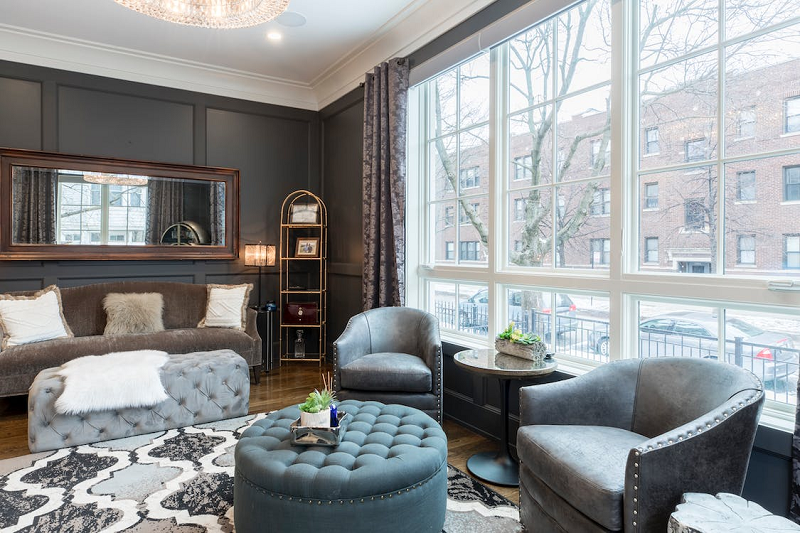
Small Space? 10 Ways To Make A Room Appear Bigger
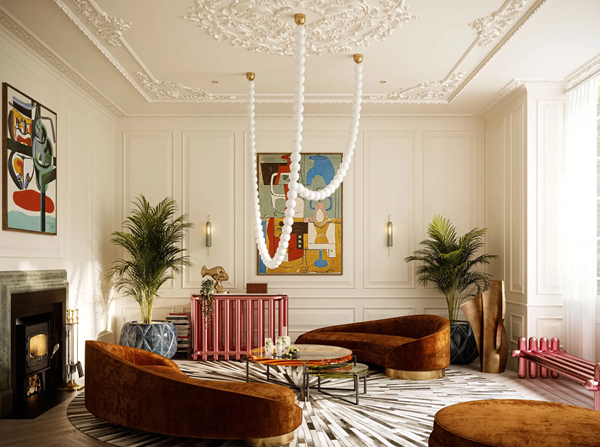
Make Your space Look Expensive
GET CAUGHT UP ON ALL THE INSPIRING DECOR TIPS:
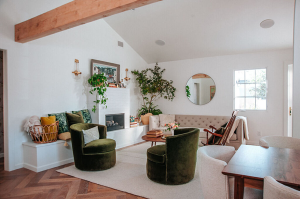
18 Fresh Decorating Ideas To Update Your Fireplace

How To Create An Art Gallery Wall


